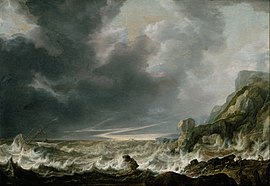Simon de Vlieger

Simon de Vlieger (c. 1601 – buried 13 March 1653) was a Dutch painter, draughtsman and designer of tapestries, etchings, stained glass windows. While he is mainly known for his marine paintings he also painted beach scenes, landscapes and genre scenes.[1]
Life
He was likely born in Rotterdam as the son of Jacob Pietersz van Zwet Bolleweck (died ca. 1634) and Lysbeth Wouters.[1] His sister Neeltje de Vlieger became a still life painter.[2] It is not known with whom he trained. He married in Rotterdam on 10 January 1627 to Anna Gerrits van Willige (died 1647). The couple had a daughter Cornelia, who married the painter Paulus van Hillegaert II. De Vlieger moved in 1634 to Delft, where he is recorded renting a house 'De Kranenburch' from 1 May 1634 for the duration of a year. A year later he moved to the house called 'De Houttuyn. He joined the Guild of Saint Luke of Delft.[1]

He then moved to Amsterdam in 1638. Here he worked until 1642 on a commission to paint decorations for the reception of Queen Maria de' Medici. He made around 1640 in Arnhem a drawing of the Rijnpoort and was some time in the period 1642 to 1643 in Kleef where he made a drawing of the Rhine. He was active in Rotterdam intermittently from 1642 to 1644 where he worked on the organ shutters of the St Laurens church. All this time he maintained a residence in Amsterdam of which he had become a citizen on 5 January 1643. He moved to Weesp, a small town on the outskirts of Amsterdam in 1650 where he died in 1653.[1]
Work
While he is mainly known for his marine paintings, he also painted beach scenes, landscapes and genre scenes. In addition to painting, he designed

The earliest known works of De Vlieger date from 1624.[2] These marine pieces were still strongly influenced by the work of Jan Porcellis and Willem van de Velde the Elder and shows several ships and rocky coasts.[4][5][6] In the 1630s and 1640s he was one of the best-known Dutch maritime painters. He moved away from the monochrome style of Jan Porcellis and Willem van de Velde the elder towards a more realistic use of colour, with highly detailed and accurate representations of rigging and ship construction. He painted ships in harbour and at sea as well as storms and shipwrecks.

During his residence in Delft, de Vlieger created a number of marine paintings showing the sea washing against a rocky shore. An example of a work from this period is the Calming the storm (1637, Art Collection of the University Göttingen).[7] The close-up treatment of this subject and the overall composition go back to the print made by Adriaen Collaert after a design by the Flemish artist Maerten de Vos. That print depicting The storm on the sea of Galilei was plate 8 in the 12-part Vita, passio et Resvrrectio Iesv Christ which was published by Jan and Raphael Sadeler in Antwerp in 1583. As in the print, de Vlieger depicts the boat in a forward tilting position but he distances himself from the print by integrating the story into the seascape rather than solely focusing on the activities on the boat.[8]
De Vlieger specialised in the detailed depiction of ships and was able to realistically depict the colours on the seawater. He depicted entire fleets and naval battles. In sketches he demonstrated his insight into
Around 1630 De Vlieger produced his first beach scene, a landscape type that he painted frequently over the following two decades.[10] From 1650 until his death he mainly painted and drew sea coasts and forests.[2]
His work was highly influential on the younger generation of maritime painters. His work was copied by other artists, such as Jan van Ossenbeeck. (ca. 1624-1674).[11] Aelbert Cuyp was familiar with the work of De Vlieger[12] and he is said to have copied the characteristic Dutch skies with clouds and rays of sun falling through De Vlieger.[13]
Notes
- ^ a b c d e f Simon de Vlieger at the Netherlands Institute for Art History
- ^ a b c Peter C. Sutton, Simon De Vlieger at Thyssen-Bornemisza National Museum
- ^ Joseph Heller, Monogrammen-Lexikon, enthaltend die bekannten, zweifelhaften und unbekannten Zeichen, so wie die Abkürzungen der Namen der Zeichner, Maler, ... u. s. w. mit kurzen Nachrichten über dieselben, 1831, p. 326
- ISBN 3-8258-2238-9, p. 286
- ^ Biography of Simon de Vlieger, National Maritime Museum Greenwich
- ^ 'Abridged Catalogue of the Pictures and Sculpture, Mauritshuis, The Hague, 2008, p. 95
- ^ *Vermeer and The Delft School, a full text exhibition catalog from The Metropolitan Museum of Art, p. 190
- ^ G. Unverfehrt, Christus und die Jünger im Seesturm at Sammlungen der Georg-August-Universität Göttingen (in German)
- ISBN 9053567135, page 89
- ISBN 1555952577, p. 150
- ^ Adam von Bartsch Le peintre graveur, J.A. Barth, Leipzig, 1854, p. 304
- ISBN 0894682865
- ISBN 9053567135, p. 89
External links
![]() Media related to Simon de Vlieger at Wikimedia Commons
Media related to Simon de Vlieger at Wikimedia Commons
